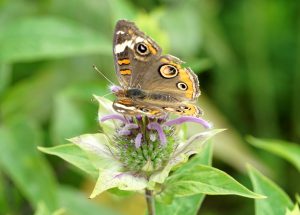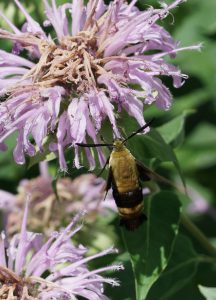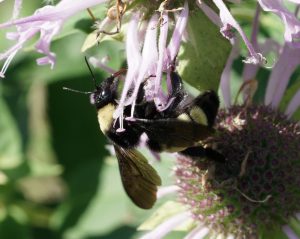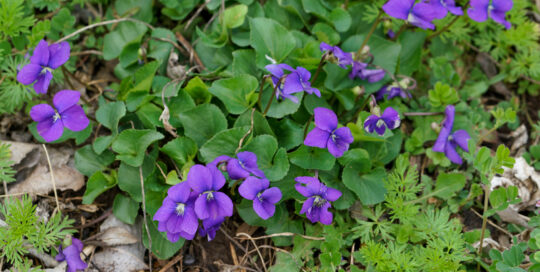Beebalm to attract bees and butterflies
Views: 3499

A few years ago, in late spring, I noticed a wide stand of tall, pale purple flowers blooming along a roadside easement near my home. They were competing successfully with Johnson grass and other brush. They were also subject to mowing and general destruction at the hands of the nearby land owner. Yet they came back cheerfully each year. So, I made note of their location, and one fall I dug up two to move to my garden. (Generally, I don’t steal flowers from roadsides because local wildlife may rely on them. In this case, I knew the wildflowers were successful and spreading, so taking a few did minimal harm.)
I didn’t know if they’d successfully transplant because, at the time, I didn’t know what they were (besides apparently indestructible). So, I waited all winter to see if anything would come up.
Next spring, much to my surprise, an entire stand of them popped up, having spread by rhizome over winter. Evidently, they really liked where I planted them: in full sun and sandy soil.
It was easy enough to identify them once they flowered. I could see the unusual flowers up close, rather than as a lavender blur as I was driving down the road. They were a beebalm of some sort, and a little research narrowed the variety to Monarda fistulosa.

Varieties of Monarda have distinctive flowers.
The flowers are so strange-looking, I just love them. So do bumblebees. And butterflies. And honeybees. You might expect a flower with “bee” in the common name to be popular with pollinators, and, indeed, my beebalm does not disappoint. I have also seen hummingbirds feeding on it.

Bees and bumblebees are attracted to beebalm.
Also known as wild bergamot, this plant is a perennial, and it is native to most of the continental United States and southern Canada. It is a member of the mint family. As such, it has a pleasant, minty smell. Historically, it has been used for a variety of herbal remedies by Native Americans, and it can be used to make a strong, herbal tea. The flowers are edible, as well.
Like many mints, wild bergamot spreads rapidly. It’s also quite tall, so I don’t recommend planting it at the front of beds. It’s very well suited for wildscaping; just give it room to do its thing. It won’t take many years to fill a large space or march along a border. It’ll compete with grass, brush, and small shrubs. It prefers full sun, and it isn’t terribly picky about soil, although it can develop mildew in soils that aren’t well aerated. It’s best to put it somewhere with good drainage.
I rarely, if ever, have to water my wild bergamot. By summer, it has finished blooming, and I cut it back significantly. You could probably leave it at full height, but I suspect in drought it would start to look spindly. It is very heat tolerant.
Of course, Monarda fistulosa is only one of many species of Monarda. There are many cultivars available, as well. They range in color from light purple and pink to deep red. Their soil and moisture requirements will vary, but all are extremely beneficial to bees, birds, and butterflies.
Meet Leslie Miller
Leslie Ann Miller shares 3.5 acres in rural Oklahoma with birds, butterflies and wide variety of animals. She is currently transforming her yard with plantings…
Leslie's Recent Posts

Early spring is time to plant native spring ephemerals






